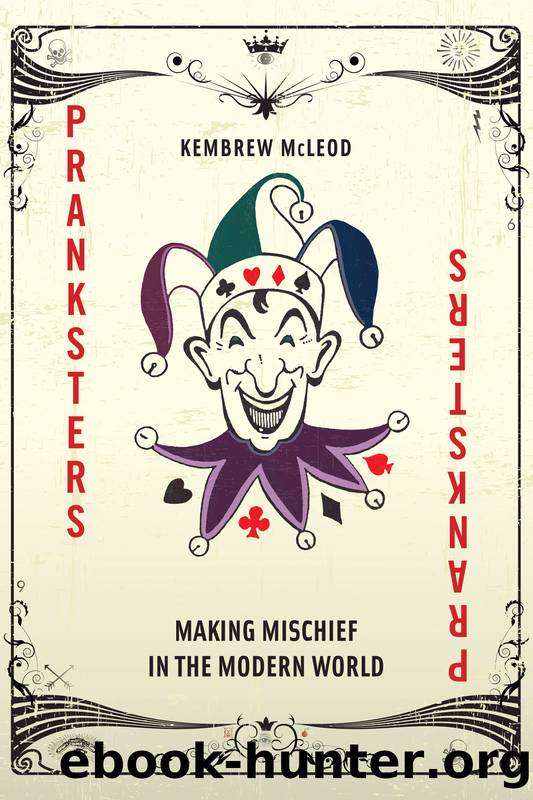Pranksters by Kembrew McLeod

Author:Kembrew McLeod
Language: eng
Format: epub
Publisher: NYU Press
Published: 2014-06-15T00:00:00+00:00
FIGHTING MEDIUMS WITH MEDIA
Preachers have populated the airwaves since the earliest days of radio, a time that coincided with the emergence of Christian fundamentalism. That religious movement pushed back against nineteenth-century Protestant leaders who adapted to more âmodernâ ways of thinking (such as interpreting biblical stories through the lens of science). Fundamentalists are often caricatured as backward and antimodern, but this perception masks the fact that they have regularly been early adopters of new media technologies. The first known Christian radio broadcast occurred in 1921, and during the 1930s Charles Fullerâs Old-Fashioned Revival Hour was the most popular American radio program of any kind. (Fittingly, the preacher got his start in Orange County, California.) But in the second half of the twentieth century, mainstream media tended to shy away from religious programming. Evangelicals, fed up with the secularism creeping into their living rooms, began to build a vast alternative communication network during the 1960s. Using church sermons, religious tracts, books, magazines, radio, and television, they spread chilling tales about Satanism and the Illuminati to millions of Americans.13
Pockets of nuttiness peppered the Midwest, but California and Virginia formed a formidable axis of insanity. Hippies provoked a siege mentality in conservative West Coast strongholds, and on the other side of the country Edgar Cayceâs flighty followers deeply troubled Pat Robertson, who fretted, âThe Spiritualist Church was making a resurgence.â Despite Robertsonâs animosity toward Spiritualists, the televangelist often invoked metaphors originally used by nineteenth-century mediums. Recounting his first experience speaking in tongues, he recalled, âIt seemed as if a heavenly teletype machine had mysteriously been activated.â Robertson and Cayce both ended up in Virginia Beach because their spiritual guidesâGod and The Source, respectivelyâinstructed them to go. The evangelical was told to start a television station there, and the mystic was led to believe he could make better use of his powers near a large body of water. Upon arriving in this small beach town in the middle of winter, Cayce and his family found little more than a hardware store, a drugstore, a restaurant, and some boarded-up souvenir shops. They wondered aloud, âWhy did the readings send us to Virginia Beach?â14
I asked similar questions while growing up in this seedy tourist trap. Even though my mom and dad were never hardcore cultish followers, they were each curious enough about the Sleeping Prophet to move across the country to Virginia Beach. There, Dottieâs and Dallasâs paths to illumination crossed, and they had a baby boy named Kembrew. (I was born on Halloween in 1970, the dawning of the Age of Aquarius, and grew up to be a university professorâwhich likely makes me the devil incarnate in Pat Robertsonâs eyes.) My parentsâ bookshelves were littered with standard-issue 1970s accouterments such as pyramid paperweights, along with several Edgar Cayce paperbacks. They were a treasure trove of wacky ideas: Astral projection! Atlantis rising! Death rays! Perpetual Motion Machines! Reincarnation! I also grew up watching Robertsonâs local UHF channel, which broadcast cartoons and sitcom favorites such as The Dick Van Dyke Show.
Download
This site does not store any files on its server. We only index and link to content provided by other sites. Please contact the content providers to delete copyright contents if any and email us, we'll remove relevant links or contents immediately.
Spell It Out by David Crystal(36083)
Professional Troublemaker by Luvvie Ajayi Jones(29621)
We're Going to Need More Wine by Gabrielle Union(19003)
The Secret History by Donna Tartt(18943)
Cat's cradle by Kurt Vonnegut(15254)
The Goal (Off-Campus #4) by Elle Kennedy(13601)
The Social Justice Warrior Handbook by Lisa De Pasquale(12165)
The Break by Marian Keyes(9335)
Crazy Rich Asians by Kevin Kwan(9220)
The remains of the day by Kazuo Ishiguro(8888)
Thirteen Reasons Why by Jay Asher(8841)
Educated by Tara Westover(8001)
The handmaid's tale by Margaret Atwood(7705)
Giovanni's Room by James Baldwin(7250)
Win Bigly by Scott Adams(7139)
This Is How You Lose Her by Junot Diaz(6831)
The Rosie Project by Graeme Simsion(6290)
Six Wakes by Mur Lafferty(6198)
The Power of Now: A Guide to Spiritual Enlightenment by Eckhart Tolle(5679)
